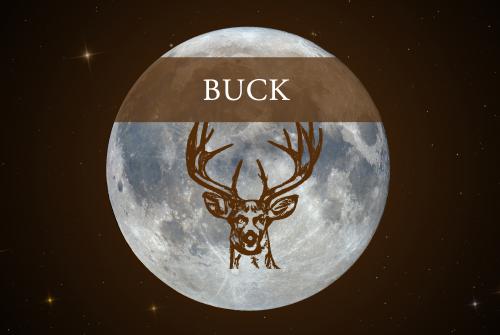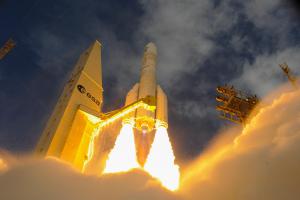Celebration of Space - July 19, 2024
This coming Sunday, July 21, 2024, at 6:20 am ET, the Moon will arrive on the opposite side of the Earth than the Sun. This last happened 29.5 days ago, and is known as the full Moon. During the full Moon, the Sun, Earth, and the Moon, are in alignment. This allows for the entire side of the Moon that faces Earth to be in direct sunlight. This alignment also has a tidal effect on Earth, which is noticeable in the ocean tides, which are exaggerated. We call this exaggeration the Spring Tide.
Like all full lunar phases, the July full Moon carries a common moniker, and goes by The Full Buck Moon. According to the Old Farmer’s Almanac, the July Moon gets its name from antler growth on adult male deer, which is in full growth this time of the year. When driving out of Newport, RI on Sunday evening, I came across a buck with an impressive set of antlers. Other names that the July Moon goes by are: The Berry Moon, The Raspberry Moon, The Thunder Moon, and The Halfway Summer Moon.
Like most of the full lunar phases this summer, the July full Moon will rise and set about 5° below the ecliptic. The Sun follows the ecliptic across the sky, and is currently close to its lowest point in our sky for the year during the nighttime period (highest during the day). With the full Moon transiting the sky below the ecliptic, the altitude of the Moon is much closer to the horizon than usual. This results in views of the Moon happening through a higher amount of atmosphere than usual, which will scatter a higher amount of the blue wavelengths of light, allowing for a rather yellowish view of the Moon, So step outside this Sunday, particularly right around Moon rise at 8:58 pm. Set out to a location with a clear view of the southeast horizon, and be there for Moon rise to catch a stunning view of the Full Buck Moon rising.
On this day, July 19, 1948, Edwin Foster (Frosty) Drew was born. He is our namesake and represents a very important part of the history of Ninigret Park – home to the Frosty Drew Observatory and Science Center. As a child Frosty Drew contracted Polio while waiting for the vaccine, which left him disabled. A graduate of Moses Brown, and Brown University, Frosty began a career in writing, which was put on hold due to his active work in preservation of the natural heritage of southern Rhode Island. A gifted speaker and leader, he successfully petitioned against the installation of a nuclear power plant where Ninigret Park and Ninigret National Wildlife Refuge (NWR) are today, and went on to chair the Rhode Island Commission on Energy, among other leadership roles in the region. In 1976, Frosty Drew died at the age of 28 as a result of his disabilities.
Frosty cared greatly about the natural habitats that Earth’s ecosystem depends on, and was tenacious in adhering to his principles therein. Today, Ninigret Park and the Ninigret NWR stand as evidence of that tenacity. The Frosty Drew Nature Center opened in 1983 as a memorial to Frosty Drew’s accomplishments, and was the first building to open in Ninigret Park. Over the years, hundreds of volunteers built on top of what Frosty had accomplished, resulting in the park-like environment that Ninigret Park is today, which was previously the Charlestown Naval Auxiliary Landing Field. So take a moment this weekend and go for a stroll in Ninigret Park and the NWR, try to find the two Dambo Trolls, check out Ninigret Pond in the NWR, have a picnic at one of the park pavilions, try to find the old military hangar foundation (hint: it’s in the parking lot north of the basketball court), check out Spaceport Rhode Island which is west of the Frosty Drew Observatory, or just walk the multi-use path through the park, and take a moment to think about the efforts of Frosty Drew and the numerous people whose efforts have made the park what it is today, which is probably what Frosty Drew would have done on his birthday.
Tomorrow, Saturday, July 20, 2024, marks the 55 year anniversary of the Apollo 11 Lunar Landing. On this day in 1969, Neil Armstrong and Buzz Aldrin spent 21 hours and 36 minutes on the surface of the Moon, becoming the first humans to set foot on Earth’s only natural satellite. In the Frosty Drew Science Center we have a 12 foot wide panoramic of the Apollo 11 landing site on the lunar surface. In the exhibit the Lunar Excursion Module (LEM) descent stage, the Apollo Lunar Surface Experiments Package, TV camera, and footprints of Armstrong and Aldrin are all visible. Be sure to stop in this summer and check out the exhibit. Now take a moment to catch up for the next human excursion to the Moon; the Artemis Mission.
On July 9, 2024, the European Space Agency (ESA) performed the first launch of the new Ariane 6 rocket, which will eventually replace the Ariane 5 rocket. The Ariane 6 is a two stage rocket. The first stage is called the Lower Liquid Propulsion Module (LLPM). Depending on the launch payload, two or four additional boosters can be attached to the LLPM. The second stage is called the Upper Liquid Propulsion Module (ULPM). During the July 9, 2024 maiden launch, the rocket successfully launched into orbit and deployed its payload. During the third burn attempt of the ULPM, which would de-orbit the second stage, the auxiliary propulsion system failed, resulting in the ULPM remaining in orbit. Over the next several weeks the ULPM stage will be visible as it passes over our region. The Frosty Drew Daily Satellite Pass Prediction Utility will commence tracking the ULPM stage this weekend, listing daily pass sighting opportunities. Be sure to check in regularly for new listings of the Ariane 6 and other bright satellites.
- Author:
- Scott MacNeill
- Entry Date:
- Jul 19, 2024
- Published Under:
- Scott MacNeill's Columns





